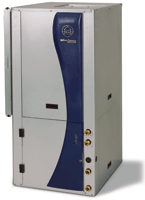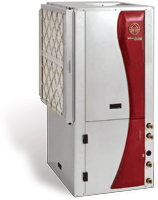

Geothermal Basics
The heart of a typical geothermal system is a ground-source heat pump that cycles water through an underground piping loop. The water piped through this loop uses soil temperature to warm or cool the heat pump's refrigerant. Significantly, the heat pump is located indoors, like a furnace, which provides advantages we'll get to shortly.
The heart of a typical geothermal system is a ground-source heat pump that cycles water through an underground piping loop. The water piped through this loop uses soil temperature to warm or cool the heat pump's refrigerant. Significantly, the heat pump is located indoors, like a furnace, which provides advantages we'll get to shortly.
While this equipment may sound exotic, its operation is fairly easy to understand when compared to that of conventional air-to-air heat pumps. A conventional heat pump is really just a central air conditioner that can reverse the flow of its refrigerant. The compressor is located outside the home, and, in the heating mode, it's able to extract some of the heat present in cold, outdoor air and deliver it indoors to a condensing coil. Unlike conventional furnaces, heat pumps don't have to create heat, they just harvest existing heat–and therein lie the savings.
Below about 10 degrees Fahrenheit, however, too little heat is present in the air and a backup heat source is needed to make up the difference, or, in many cases, take over entirely. Even within a heat pump's effective operating range, efficiency is directly tied to ambient temperature. The colder it gets, the less heat is available and the less efficient the system becomes.
In contrast, a ground-source heat pump, with its underground piping loop, is able to tap a warmer, more stable heat source. The soil below frost level–4 ft. to 6 ft. deep–stores the sun's energy at a more or less constant level, with temperatures keyed to latitude. Subsoil temperatures range from the low 40s in the North to the low 70s in the South.
For purposes of comparison, we'll use the 55 degrees F soil temperature common in much of the Midwest and Central Plains. This area of the country suffers some extreme temperatures, but also has a fair number of mild days, so it's a reasonable choice.
With a ground temperature of 55 degrees F, the system needs to boost the heat a mere 15 to 20 degrees to reach a comfortable indoor temperature. Compare this to the 40 to 60 degrees maximum differential that an air-to-air heat pump may handle, and even greater differentials expected of standard furnaces, and the logic comes into focus pretty quickly. The only influence outside air temperature has on the equation is in the home's ability to retain heat. Houses lose heat faster on colder days, so all systems work harder in cold weather. But while a ground-source heat pump may need to run more often on these days, it doesn't run less efficiently.
The geothermal principle works about as well for air conditioning. Instead of an outdoor compressor laboring against the heat of the day having to use hot air as its heat-shedding medium, a ground-source heat pump operates indoors, using ground temperature as its starting point. The result is a 20 percent to 40 percent savings over conventional heat pumps and air conditioners.
Of course, lower soil temperatures will reduce heating efficiencies and warmer soil will cut into air-conditioning savings. On average, however, ground-source heat pumps deliver three to four times the energy they consume.
Geothermal Basics

810-357-6479





